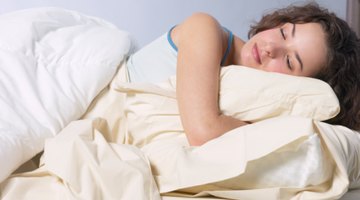How to Kill Bed Bacteria
Bacteria is a common problem in sheets and mattresses. Human skin oil and sweat permeates the bedding materials over time as we sleep and this provides an ideal environment for bacteria to breed and prosper. Regular cleaning and diligence is needed to keep your bed as bacteria-free as possible.

Things You Will Need
- Washing machine
- Laundry detergent
- Dryer
- White vinegar
- Spray bottle
- Absorbent cloth
- Steam cleaner
- HEPA-filtered vacuum
Bacteria is often resistant to being killed, but certain substances along with heat are useful in eliminating them from your sleeping quarters.
-
Pull off all your sheets and pillow cases, and wash them in a washing machine on the hottest setting using detergent. The hot water is useful in killing bacteria and the soap helps remove it as well as cleans out the skin oil and sweat that the bacteria feed on. Wash your comforter as well if it will fit safely in your washing machine. If it is too thick, leave it out since it could damage your machine.
-
Place the bedding materials in the dryer on the hottest setting as well after they're washed. The added heat helps to further kill off any remaining bacteria.
-
Spray a solution of white vinegar and water in a half-and-half solution onto the mattress surface using a spray bottle. White vinegar is a useful disinfectant that kills many different types of bacteria on contact. Allow it to sit on the mattress for several minutes and than absorb it up with an absorbent cloth.
-
Run a steam cleaner over the bed. The hot steam kills bacteria since most microorganisms cannot survive in extreme heat. Use a cleaner that is specifically designed for mattresses to ensure the mattress doesn't soak up too much water from the steam. Follow all operating instructions for best results.
-
Vacuum the mattress with a HEPA-filtered vacuum to pull out dust mites and other debris while also circulating air through the mattress material to help with drying.
Warning
Avoid using a steam cleaner on water beds or memory foam since it could damage them.
References
Writer Bio
Michael Davidson started writing screenplays in 2003 and has had a screenplay professionally produced. He has also studied martial arts since 1990 and has worked as a licensed security specialist. Davidson has written articles for various websites. He is a graduate of Michigan State University and holds a Bachelor of Arts in advertising.
Photo Credits
- Hemera Technologies/AbleStock.com/Getty Images
- Hemera Technologies/AbleStock.com/Getty Images
More Articles



